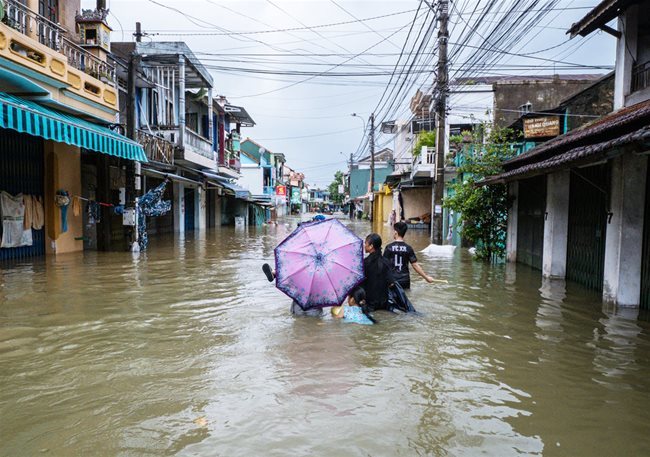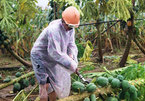Yet the State’s budget stands out as the only financial source for disaster compensation, while risk-sharing prevention financial tools such as insurance have so far played an insignificant role.

Vietnam is categorized as a nation facing high risk of natural calamities. In the first 10 months of 2020, preliminary statistics showed that property damages caused by natural disasters reached VND10 trillion, or some US$430 million.
More disasters strike causing bigger devastating impacts
Overall losses from world-wide natural catastrophes in the first half of 2020 totaled US$68 billion, in which US$27 billion in damages are insured losses, equivalent to 39.7% of the total losses, according to Munich Re, a reinsurance company. That means up to 60% of financial losses are not covered, or in other words, businesses or governments are to bear all damages.
Those who opine that climate change is not serious may have to think twice when the number of natural disasters is rising year after year, causing damages four times greater than in 1970, according to statistics of the world’s leading reinsurance group, Swiss Re. Accordingly, cases of natural disasters has skyrocketed from 48 in 1970 to 202 in 2019, the highest ever. More noteworthily, from 2010 up to now, the tally of natural disasters has outstripped the number of man-made disasters.
Also according to Swiss Re, last year’s world-wide financial losses by both natural and man-made catastrophes amounted to US$146 billion, with US$60 billion being insured losses, equivalent to 36.6% of the total damages. The ratio of insured damages to the total damage varies greatly from one region to another in the world. North America and Australia topped the list of regions with the highest rates of insured damage, at 60.9%, followed by Latin America and the Caribbean (43.7%), Europe (39.7%), Asia (27.7%), and lowest in Africa with 15%.
Uninsured losses are shown in protection gap, which in 2019 reached US$86 million. If the 10-year moving average is preferred, the need to be covered from 1970 to now has increased steadily in absolute numbers but gradually stabilized in ratio.
What insights Vietnam can gain from global experience
Many international organizations have fully admitted and warned that climate change is a serious and global problem. The insurance industry, above all, are also quite aware of this risk since a single disaster may completely wipe away thousands of houses and throw the equivalent families into disarray.
Nonetheless, catastrophe insurance related policies around the world in general have been so far unable to tackle the problem because of the most important reason: market failure.
Many households would turn down catastrophe insurance if their outlooks on involved risks are unmatched with reality, meaning that they underestimate the risks. They have a reason to do so while, in their eyes, the frequency of calamities is low although if observed in the long run, it does actually increase over the time. Meanwhile, insurance companies do not feel the urge to come up with new products and market development as they themselves are not insured on the financial market.
To put it differently, government interference is as desperately needed as the invisible hand of the market.
Governments usually cope with natural disasters through the combination of ex-ante and ex-post measures, such as investment in infrastructure resilience, self-insurance through accruals of disaster prevention funds over the years, and support the market for catastrophe insurance through catastrophe bonds.
As per the insurance market, the first important interference relates to insurance premium which needs to obtain the ratio of premium to have the lowest insurance multiple that satisfies both demand and supply. Next is the financial market development, which, in this case, involves the catastrophe bond market so that insurance companies can also shield themselves.
However, experts have also warned that each nation in line with her different circumstances and level of risks should have its own optimal choice. To do this, it is necessary to calculate the risk level of natural disasters—frequency and severity. What’s more, it is also necessary to include the risks that affect a large area of the territory or just a certain region or area.
To cope with damages caused by natural disasters also means the exchange between growth and public debt. For small economies, a recommendation often given is to reduce the cost of insurance for the population and ensure less serious but more frequent risks.
Once a natural disaster insurance market is already in place, compensation needs to be swift for affected households or businesses. For instance, the French Government will pay insurance claims when it declares an event as a natural disaster. Accordingly, when the Government declares a disaster, the property insurance policies in the affected area are automatically compensated within a maximum of three months.
Damages due to natural disasters in Vietnam are becoming severer and the Vietnamese Government should no longer rely solely on the national disaster prevention and control fund or relief funds. Instead, it should create conditions for the growth of catastrophe insurance market, such as giving insurance fee support, facilitating the catastrophe bonds market, expanding insurance funds in coordination with regional countries, and turning home insurance into an important insurance profession as many countries have been doing.
Vo Dinh Tri
HCMC University of Economics, IPAG Business School Paris and AVSE Global
SGT

Farmers in central region struggle to recover after historic floods
After felling 300 papaya trees in his farm, Nguyen Nam, a 60-year-old farmer in Dai Loc District, central Quang Nam Province, does not want to think about the historic floods that lashed the region last month.